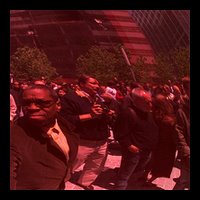The Aggressive Use of “Urban Art”
 After recently attending the public presentation of “Balloon Flower (Red)” at 7 World Trade Center, and listening to the developer’s vague description of the purpose of public art, it becomes clear that FAR-based zoning or building code had the effect of opened a gap in the psychological and build environments.
After recently attending the public presentation of “Balloon Flower (Red)” at 7 World Trade Center, and listening to the developer’s vague description of the purpose of public art, it becomes clear that FAR-based zoning or building code had the effect of opened a gap in the psychological and build environments. This code changed the primary size limitation for buildings from height and setback lengths to Floor Area Ratio (FAR) calculations. As a bonus to developers, buildings which volunteered to accept large setbacks in downtown areas (giving private real estate back to the city in the form of paved plazas) were rewarded the ability to build more square footage in a market that set rent based on leaseable area. This meant that developers could suddenly earn more money from the same amount of land. The kind of organization that could organize the large amounts of initial capitol and land to benefit from these bonuses, and kind of tenant that preferred the large, modern, stark skyscrapers that formed from the zoning was the corporation.
The hidden cost to these corporations was some loss of control; they had to turn over the use of their front yards, the new urban plaza, to the general public. The spirit of the law provided these spaces as public amenities, but private interests strove to narrowly define their use. For example, by city law, little restriction can be placed on meeting or gathering in these spaces, but there is modest incentive for it. Their noticeable lack of usable fixtures declares that these spaces are not intended for shelter, sitting, or reclining. Very little furniture is typically provided, and what little is offered is usually designed to discourage prolonged use. The welcome mat is taken in.
The accusation here is that these spaces are ironically, and intentionally, design for transience.
The tie-wearing crowd isn't keen on "the public" getting comfortable in privately owned public space. Skateboarders, rollerbladers, street musicians, street performers, pan-handlers, and the homeless are all members of that public sphere. Marginalized, they sometimes use public space in unpredictable and impromptu uses that stand in high contrast to the image of highly controlled, institutionally rooted, and hermetically sealed cleanliness. The purchasers of corporate modernism subscribed and exuded the kind of control to which democratically used public space was an anachronism. That separation played out in the space between the sidewalk and the front door of these skyscrapers.
In this context, it is easy to see "Urban Art" in an aggressive use, as a scuttling of public spaces. These trophies who are most expressive when set in large, flat, featureless spaces insistently consumed the space that was gifted to cities, aggravating most consumptions like sport, organized rallies, improvised markets, and the like.

0 Comments:
Post a Comment
<< Home